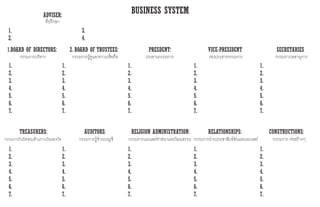1 of 1
Download to read offline

Ad
Recommended
Los mosuo, Mar©¬a t. y Bianca c.Rosa P©”rez
?
Los Mosuo viven en las provincias chinas de Yunnan y Sichuan. Celebran la mayor©¬a de edad a los 13 a?os con rituales diferentes para ni?as y ni?os. Practican el amor libre y los matrimonios ambulantes. Su cultura se centra en las mujeres y las madres desempe?an el papel m©ós importante en las familias y comunidades. Consideran el Lago Lugu sagrado por su mitolog©¬a.5
5apskowro
?
This document outlines the space requirements for a multi-specialty medical facility including a dental suite with 9 operatories, an OB-GYN suite with 16 exam rooms and support spaces, a plastic surgery suite with 6 exam rooms, and shared spaces like a cafeteria, lobby, classrooms, and gift shop. The goal is to improve efficiency and reduce stress through unified spaces, single-handed exam rooms, and optimized zoning and adjacencies between services and support areas.Cronica yamilec riascosYamilec Riascos MOnta?o
?
Este documento describe la experiencia de Yamilec Riascos Monta?o en una capacitaci©«n para mejorar su pr©óctica docente. La capacitaci©«n incluy©« actividades de autoexploraci©«n personal que le permitieron descubrir aspectos de su vida que afectaban su trabajo. Tambi©”n aprendi©« nuevos conocimientos y actualiz©« los existentes a trav©”s de presentaciones y clases. Aunque el uso de la plataforma digital y el video-beam presentaron desaf©¬os iniciales, espera aplicar lo aprendido para mejorar las competencias de sus estudiantes. Yamilec con????????????????????2554 english
????????????????????2554 englishWataustin Austin
?
This document describes the chanting and procedures involved in Buddhist ordination ceremonies in the Ukasa style. It involves chanting verses while kneeling, bowing, and standing in order to pay homage. The ordinand seeks refuge in the Buddha, Dhamma, and Sangha and receives the ten precepts from the preceptor. They request dependence on their preceptor and undergo a question and response examination regarding their robes, bowl, and qualifications before receiving full ordination.Morning evening chanting(david)
Morning evening chanting(david)Wataustin Austin
?
This document contains Pali chanting and prayers used in Buddhist ceremonies. It begins with an introduction describing the purposes of chanting in Buddhism, such as remembering the Buddha's teachings and concentrating the mind. The document then provides the full text of several chants and prayers, including dedications of offerings, praise for the Buddha, Dhamma, and Sangha, and reflections on impermanence, non-self, and ending suffering. The chants are meant to be recited by monks, novices, and laypeople during morning ceremonies.Bookchant
BookchantWataustin Austin
?
This document contains chants and teachings used in Buddhist practice, including:
- The Anekajati Gatha, a poem about the endless cycle of rebirth.
- The description of dependent origination, explaining how ignorance leads to suffering through a chain of causation.
- A list of the different types of conditional relations between phenomena.
- Ten reflections for monks to contemplate, such as how one's life now depends on others' gifts and how all that is pleasing will decay.???????????? (1)
???????????? (1)Wataustin Austin
?
The document contains a complex arrangement of symbols and characters, seemingly lacking coherent content or a clear narrative. Its cryptic nature suggests it may involve abstract concepts or coded information. This format complicates understanding and interpretation.???????????? (1) (1)
???????????? (1) (1)Wataustin Austin
?
Ė├╬─ĄĄ░³║¼Čįė┌─│Ė÷ų„╠ŌĄ─Ė┤įėą┼ŽóŻ¼╔µ╝░ČÓĖ÷Ė┼─Ņ║═╝╝╩§ŽĖĮ┌ĪŻ─┌╚▌╩╣ė├┴╦ČÓųųĘ¹║┼║═ė’čįŻ¼│╩Žų│÷ĮŽĖ▀Ą─ū©ęĄąįĪŻ╬─ĄĄš¹╠ÕĮß╣╣Ė┤įė, Ūę░³║¼╔Ņ░┬Ą─č¦╩§╠ų┬█ĪŻMore Related Content
More from Wataustin Austin (20)
????????????????????2554 english
????????????????????2554 englishWataustin Austin
?
This document describes the chanting and procedures involved in Buddhist ordination ceremonies in the Ukasa style. It involves chanting verses while kneeling, bowing, and standing in order to pay homage. The ordinand seeks refuge in the Buddha, Dhamma, and Sangha and receives the ten precepts from the preceptor. They request dependence on their preceptor and undergo a question and response examination regarding their robes, bowl, and qualifications before receiving full ordination.Morning evening chanting(david)
Morning evening chanting(david)Wataustin Austin
?
This document contains Pali chanting and prayers used in Buddhist ceremonies. It begins with an introduction describing the purposes of chanting in Buddhism, such as remembering the Buddha's teachings and concentrating the mind. The document then provides the full text of several chants and prayers, including dedications of offerings, praise for the Buddha, Dhamma, and Sangha, and reflections on impermanence, non-self, and ending suffering. The chants are meant to be recited by monks, novices, and laypeople during morning ceremonies.Bookchant
BookchantWataustin Austin
?
This document contains chants and teachings used in Buddhist practice, including:
- The Anekajati Gatha, a poem about the endless cycle of rebirth.
- The description of dependent origination, explaining how ignorance leads to suffering through a chain of causation.
- A list of the different types of conditional relations between phenomena.
- Ten reflections for monks to contemplate, such as how one's life now depends on others' gifts and how all that is pleasing will decay.???????????? (1)
???????????? (1)Wataustin Austin
?
The document contains a complex arrangement of symbols and characters, seemingly lacking coherent content or a clear narrative. Its cryptic nature suggests it may involve abstract concepts or coded information. This format complicates understanding and interpretation.???????????? (1) (1)
???????????? (1) (1)Wataustin Austin
?
Ė├╬─ĄĄ░³║¼Čįė┌─│Ė÷ų„╠ŌĄ─Ė┤įėą┼ŽóŻ¼╔µ╝░ČÓĖ÷Ė┼─Ņ║═╝╝╩§ŽĖĮ┌ĪŻ─┌╚▌╩╣ė├┴╦ČÓųųĘ¹║┼║═ė’čįŻ¼│╩Žų│÷ĮŽĖ▀Ą─ū©ęĄąįĪŻ╬─ĄĄš¹╠ÕĮß╣╣Ė┤įė, Ūę░³║¼╔Ņ░┬Ą─č¦╩§╠ų┬█ĪŻ???????????? English
- 1. BUSINESS SYSTEM 1.BOARD OF DIRECTORS: 2. BOARD OF TRUSTEES: PRESDENT: VICE-PRESIDENT SECRETARIES TREASURERS: AUDITORS: RELIGION ADMINISTRATION: RELATIONSHIPS: CONSTRUCTIONS: ??????????????/????????????????????????? ????????????? ???????????????? ???????????????? ????????????????????????????????? ?????????????????? ?????????????????????????????? ?????????????????????????????????? ???????-????????? ADVISER: 1. 2. 3. 4. 1. 2. 3. 4. 5. 6. 7. 1. 2. 3. 4. 5. 6. 7. 1. 2. 3. 4. 5. 6. 7. 1. 2. 3. 4. 5. 6. 7. 1. 2. 3. 4. 5. 6. 7. 1. 2. 3. 4. 5. 6. 7. 1. 2. 3. 4. 5. 6. 7. 1. 2. 3. 4. 5. 6. 7. 1. 2. 3. 4. 5. 6. 7. 1. 2. 3. 4. 5. 6. 7. ?????????
